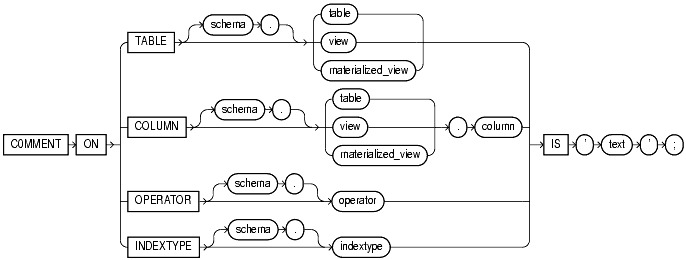| Oracle9i SQL Reference Release 2 (9.2) Part Number A96540-02 |
|
|
View PDF |
| Oracle9i SQL Reference Release 2 (9.2) Part Number A96540-02 |
|
|
View PDF |
Use the COMMENT statement to add a comment about a table, view, materialized view, or column into the data dictionary.
You can view the comments on a particular table or column by querying the data dictionary views USER_TAB_COMMENTS, DBA_TAB_COMMENTS, or ALL_TAB_COMMENTS or USER_COL_COMMENTS, DBA_COL_COMMENTS, or ALL_COL_COMMENTS.
To drop a comment from the database, set it to the empty string ' '.
See Also:
|
The object about which you are adding a comment must be in your own schema or:
COMMENT ANY TABLE system privilege to add a comment to a table, view, or materialized view.COMMENT ANY INDEXTYPE system privilege to add a comment to an indextype.COMMENT ANY OPERATOR system privilege to add a comment to an operator.comment::=

Specify the schema and name of the table, view, or materialized view to be commented. If you omit schema, then Oracle assumes the table, view, or materialized view is in your own schema.
Specify the name of the column of a table, view, or materialized view to be commented. If you omit schema, then Oracle assumes the table, view, or materialized view is in your own schema.
Specify the text of the comment.
| See Also:
"Text Literals" for a syntax description of 'text' |
Specify the name of the operator to be commented. If you omit schema, then Oracle assumes the operator is in your own schema.
Specify the name of the indextype to be commented. If you omit schema, then Oracle assumes the indextype is in your own schema.
To insert an explanatory remark on the job_id column of the employees table, you might issue the following statement:
COMMENT ON COLUMN employees.job_id IS 'abbreviated job title';
To drop this comment from the database, issue the following statement:
COMMENT ON COLUMN employees.job_id IS ' ';